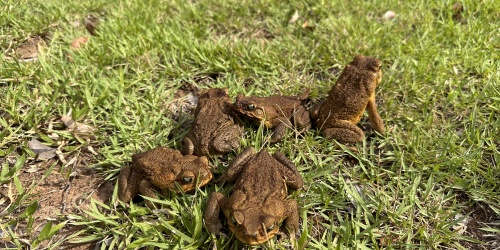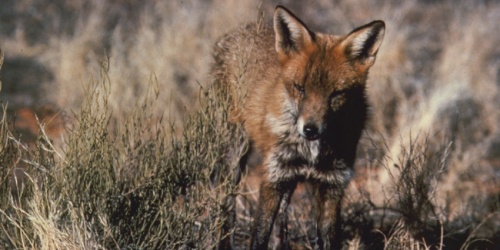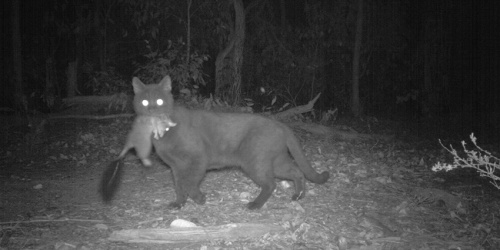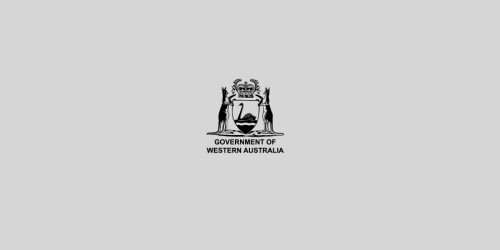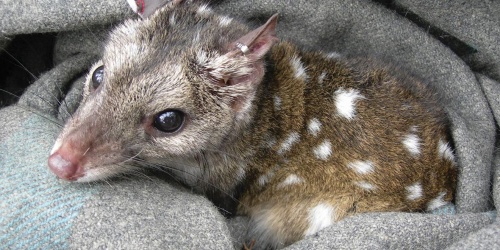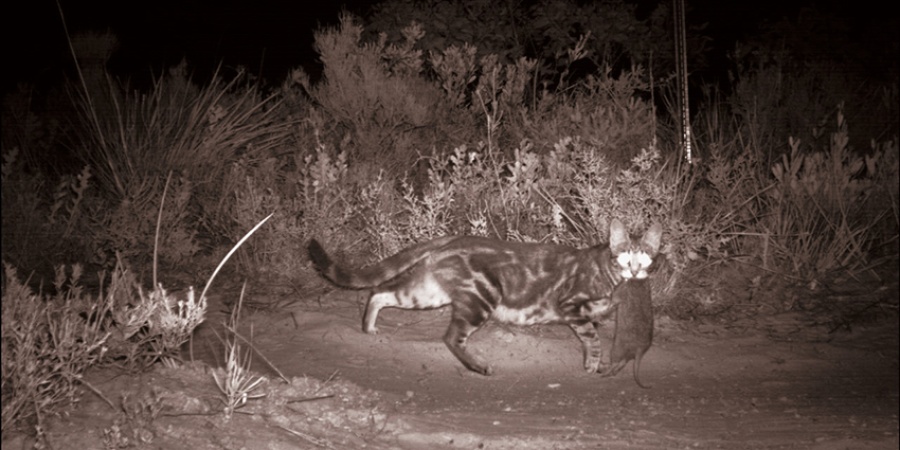
Feral cat captured by a remote sensing camera and carrying a bandicoot. Photo - DBCA
The impact of invasive animals on Western Australia's biodiversity
The presence of invasive species has consistently been identified as one of the most significant threats to WA’s native species and ecosystems. The Australian Government has identified foxes and feral cats as a key cause of the extinction and decline of dozens of native animal species across Australia.
Managing Western Australia's invasive animal problem
DBCA's primary objective is to manage invasive animals where they impact conservation values, such as threatened flora and fauna species. However, conserving threatened plants and animals in Western Australia faces significant challenges due to various factors.
Invasive animals have become extremely well-adapted to the Australian environment. With no natural predators, high population growth and high mobility, invasive animals have had minimal resistance and competition as they have spread. The elusive behaviour of some species, combined with their ability to learn and transfer intergenerational avoidance behaviour towards baiting, has exacerbated management challenges, necessitating the use of a range of management techniques to achieve optimal control.
Invasive animals are also distributed across vast, remote, and sometimes extremely inaccessible terrain. As mainland landscapes and reserves are open systems, re-invasion is a high risk. Due to these open systems, the management of invasive animals is often across multiple jurisdictions and tenures, making multi-stakeholder collaboration and contribution essential.
The extent of these challenges means that DBCA must employ prioritisation strategies and identify effective and efficient management techniques to tackle this issue.
A prioritisation process considers the conservation status of key native fauna species, distribution, vulnerability to introduced animals and the likelihood of recovery with appropriate control. This prioritisation process and consideration of feasbility and likelihood of success of control options inform the priorities for invasive animal management activities.
Legislation and policy that underpins invasive animal management in WA
National and state-level policies and strategies underpin invasive animal management undertaken in WA.
| National Threatened Species Strategy | National strategy to provide stakeholders with a guide to effective planning and management efforts. View the National Threatened Species Strategy on the Australian Government website. |
| Australian Pest Animal Strategy | National strategy to provide stakeholders a clear set of best practice guidelines to facilitate stakeholder coordination to guide effective pest animal management efforts. View the Australian Pest Animal Strategy on the Australian Government website. |
| Environment Protection and Biodiversity Conservation Act 1999 | National legal framework to protect and manage nationally and internationally important flora, fauna, ecological communities and heritage places. Identifies rabbits, European red foxes, feral cats, feral pigs and cane toads as priority species requiring management in Australia to prevent their spread and impact on threatened species and ecosystems. View the Environmental Protection and Biodiversity Conservation Act web page. |
| Key threatening processes | Listed Key Threatening Processes are available on the Australian Government website. |
| Threat abatement plans | Approved threat abatement plans are available on the Australian Government website. |
| Biodiversity Conservation Act 2016 (BC Act) | The BC Act provides a legal framework to conserve the state's biodiversity, manage rare and priority species, promote sustainable land use, and facilitate responsible land management practices. It plays a crucial role in protecting the natural environment while allowing for responsible development and land use. It protects threatened fauna, including through the control and eradication of invasive species that negatively impact WA's biodiversity. |
| Conservation and Land Management Act 1984 (CALM Act) | The CALM Act provides a legal framework that guides the conservation of the environment and the responsible management of land and natural resources in Western Australia. It helps protect the state's unique ecosystems and biodiversity while providing a legal framework for sustainable land use and development. |
| Biosecurity and Agriculture Management Act 2007 (BAM Act) | The BAM Act provides a legal framework for regulating and managing the introduction and impact of environmental and agricultural pests in WA. This Act enables the WA Government to declare certain pests as either prohibited or declared pests to regulate the control, movement, sale and cultivation of species that pose a significant risk. |
| Animal Welfare Act 2002 | All lethal control methods, when considering the management of invasive animals, must be humane and be undertaken in accordance with the Animal Welfare Act. |

